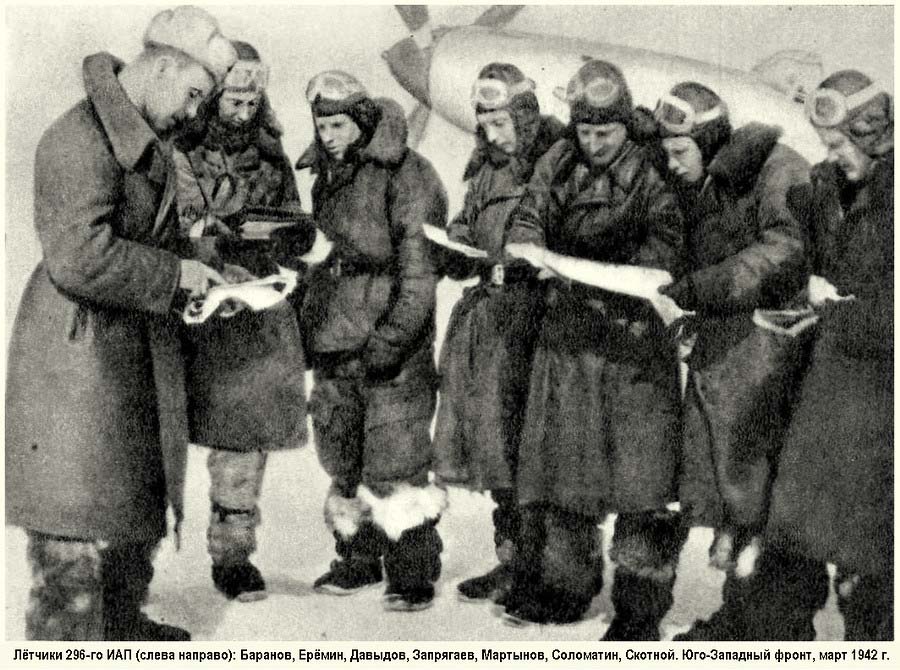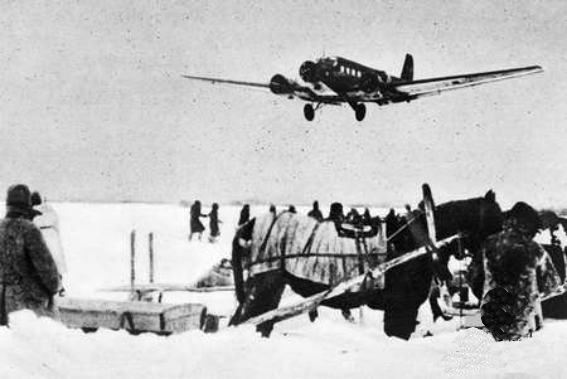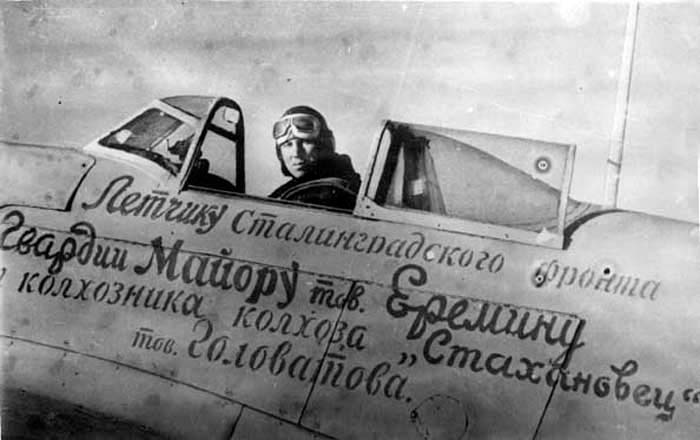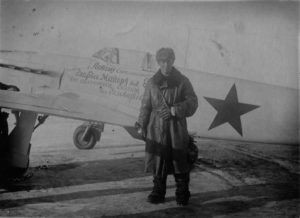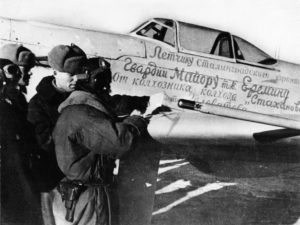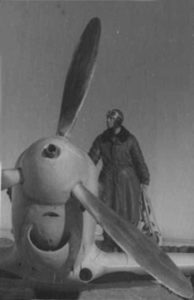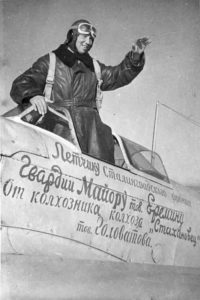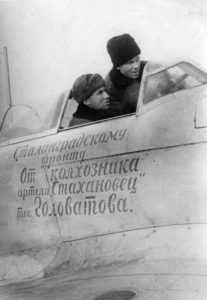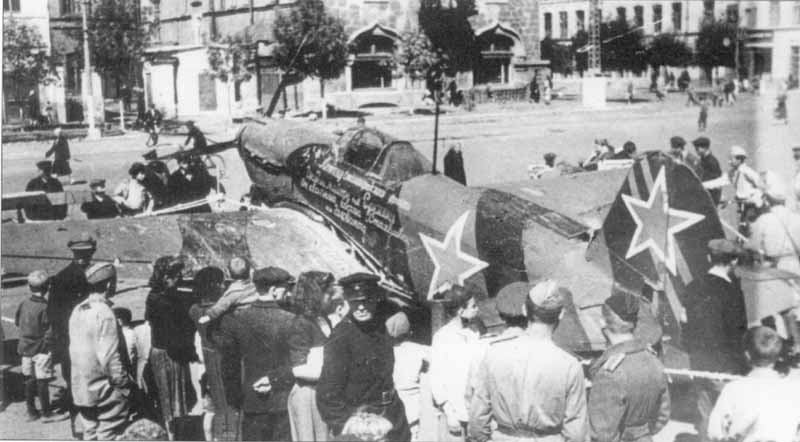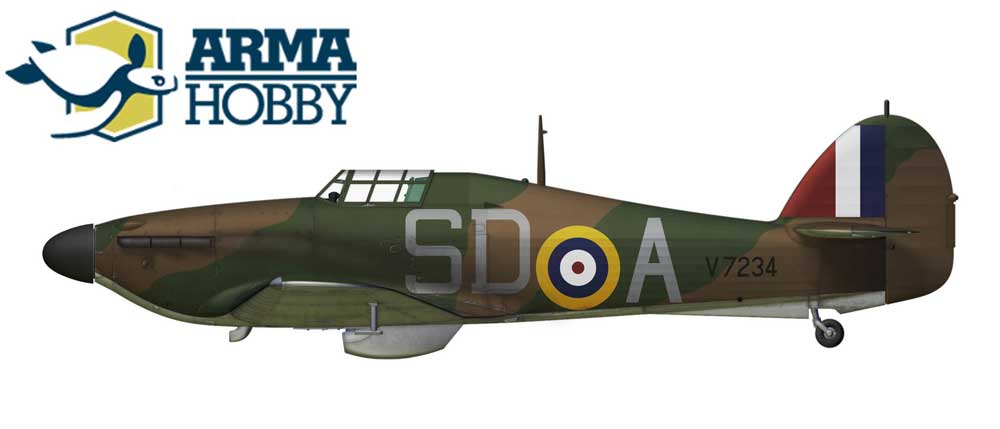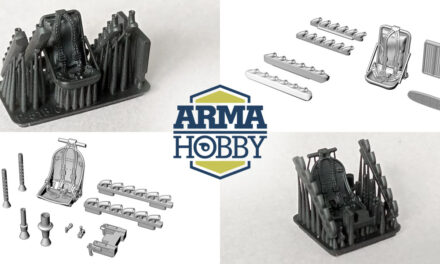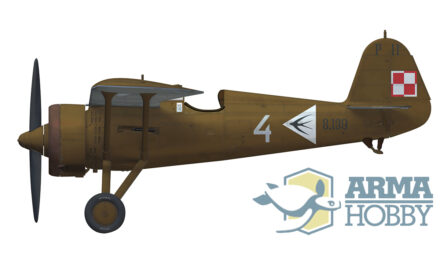One of the most recognized Yaks of the war was an unexpected gift for Boris Nikolayevich Yeryomin. He received it on behalf of the pilots fighting over Stalingrad. However, he had been distinguished pilot in previous combats. This is his story.
Boris Yeriomin – seven against twenty-five
 During the struggle over Stalingrad Boris Yeryomin had already been a distinguished pilot. He became famous when on the 9th March 1942, while south of Kharkhov, he lead seven Yaks-1 of 296th IAP ( Fighter Aviation Regiment) to attack twenty-five enemy planes (six Ju-87 Stuka, one Ju-88 and twelve Me-109F carrying bombs escorted by six Me 109Fs). It was extremely difficult to sneak towards enemy formation without being seen but he managed to do it. Soviet pilots did impossible. German bombers jettisoned bombs and started retreat towards ground. The combat went down from 2000 to 50 metres. During the short struggle, Soviet pilots shot down 7 enemy planes and forced German pilots to retreat. Every kill was confirmed by ground forces – all seven were found. The combat redouble in the Soviet press and war propaganda. Nine days later 296th IAP was renamed and became 72nd Guard Fighter Aviation Regiment. After the combat Gen. F. Y. Falalyeyev, CO of the South-Western Front Air Force suggested Yeryonim should have received the title of the Hero of the Soviet Union. But he declined, saying that all pilots had fought bravely. Eventually he received the title but this happened 48 years later, in 1990. Until the end of the war Yeryomin grew 15 pilots who received the title of the Hero of the Soviet Union.
During the struggle over Stalingrad Boris Yeryomin had already been a distinguished pilot. He became famous when on the 9th March 1942, while south of Kharkhov, he lead seven Yaks-1 of 296th IAP ( Fighter Aviation Regiment) to attack twenty-five enemy planes (six Ju-87 Stuka, one Ju-88 and twelve Me-109F carrying bombs escorted by six Me 109Fs). It was extremely difficult to sneak towards enemy formation without being seen but he managed to do it. Soviet pilots did impossible. German bombers jettisoned bombs and started retreat towards ground. The combat went down from 2000 to 50 metres. During the short struggle, Soviet pilots shot down 7 enemy planes and forced German pilots to retreat. Every kill was confirmed by ground forces – all seven were found. The combat redouble in the Soviet press and war propaganda. Nine days later 296th IAP was renamed and became 72nd Guard Fighter Aviation Regiment. After the combat Gen. F. Y. Falalyeyev, CO of the South-Western Front Air Force suggested Yeryonim should have received the title of the Hero of the Soviet Union. But he declined, saying that all pilots had fought bravely. Eventually he received the title but this happened 48 years later, in 1990. Until the end of the war Yeryomin grew 15 pilots who received the title of the Hero of the Soviet Union.
Seven fighters of the combat on 9 March 1942, from left Baranov, Yeryomin, Dawidov, Zapryagajev, Martynov, Solomatin, Skotnoy. In the background is Yeryomin’s aeroplane: Yak-1 No 23 with red spinner and with skies. Propaganda photo via Yak Anthology
Boris Yeryomin’s pilot career
Boris Nikolayevich started his flying career in 1932 when joined the mechanic and aviation school. In 1938 he took part in the battle of Lake Khasan, where he served as a mechanic in the bomber force. Later he went to the Katchynsk Pilot School where he learnt to fly and became a fighter pilot. He fought Germans since the beginning of Barbarossa. At first was flying Polikarpov I-16 in the 160th Reserve Fighter Aviation Regiment (soon reformed as regular 296th IAP) during fights near Odessa. At the beginning of 1942, during the famous “seven against 25” combat, he flew white Yak-1 “23” with spinner painted red and ski undercarriage. In September 1942, during the Battle of Stalingrad, his mount was Yak-7 in black and green camouflage. His plane had the tactical number overpainted.
In October 1942 he was transferred to 9th GIAP and promoted to the flight commander. But he did not stay long there as in November he became the CO of the 273rd IAP, soon renamed 31st GIAP. One month later he was ordered to go to Saratov, his hometown, where he was going to receive an aircraft prepared especially for him.
Table: A list of Boris Nikolayevitch Yeryomin’s known victories. It contains combined data included in different sources. The total number of victories shown in the table differs from the number mentioned in his biographies: 23 victories (8 individual and 23 shared). Different sources show different number of victories (for example while flying Yak-1b he was credited with 5 or 7 kills)
|
296th IAP/73rd GIAP |
||
| 4th March 1942 | Ju-88 (shared) and two Me-109 | Kiseli-Sheblinka |
| 9th March 1942 | Me-109 (shared) | Kiseli |
| 10th March 1942 | Me-110 (shared) | Nikolayevka |
| 15th May 1942 | Me-109 (shared) | Mikhailovo |
| 16th May 1942 | Ju-88 (shared) | Lichaczewo Likhatchevo |
| 17th May 1942 | Ju-88 (shared) | Lozovenka |
| 31st May 1942 | Ju-88 | Guryevka |
| 5th June 1942 | Me-109 | near Stalingrad |
| 10th June 1942 | Me-109 and Ju-87 | Bulatselovka |
| 23rd July 1942 | Ju-88 (shared) | Kosoklyutchansky |
| 27th July 1942 | Me-109 | Illaryonovsky |
| 24th August 1942 | Me-109 | South-western Erzovka |
|
31st GIAP |
||
| January 1943 | Ju-52 | Żytowo Zytovo |
| February 1943 | Me-109 | KotielnikowoKotyelnikovo |
| February 1943 | Ju-87 | Manycz Manych |
| March 1943 | Ju-88 | Batajsk Bataysk |
| March 1943 | Fw-189 (shared) | Woroszyłowgrad Vorosilovgrad |
| 16th May 1943 | Me-109 (shared) | rejon Krasnopolski the Krasnopol region |
|
6th GIAD Command Flight |
||
| 10th April 1944 | Me-109 | Kirk – Iszun Kirk-Ishun |
. .
The Battle of Stalingrad on the ground and in the air
Ju-87 Stuka bombing on Stalingrad, 2 October 1942, photo Bunesarchiv
It is hard to overestimate the Battle of Stailngrad as capturing the city by Germans would have led to closing Volga as the transport artery and could have been a nail in the USSR coffin. Day by day, Soviet and German forces were fighting hard in the ruins of the city, regardless the weather conditions. Even hunger could not stop enemies. The air war for Stalingrad was also very important element of the whole battle. In the first phase, since August 1942, Soviet ground forces were trying to find the best way to diminish their loses inflicted by the Luftwaffe. To do this they keep their positions as close to German lines as possible which made it more difficult for German pilots and artillery to support Wehrmacht. Soldiers often came to close quarters. German called that “Rattenkrieg” – “the Rat War”. The suppiles for the Red Army units in the city were transported at nights across the Volga river. The Sovied High Command very quickly realized the importance of the battle and concentrated large force of air units to protect Soviet positions from the Luftwaffe raids. One of the pilots who became famous was a female pilot Lilia Litviak. One of the aces was Maj. Boris Yeryomin.
Ju-52 landing in Stalingradzie, Winter 1942/43, photo wikipedia
The second phase started on the 19th November 1942 with the Red Army counter offensive which led, three days later, to complete encirclement of German 6th Army and elements of the 4th Panzer Army. Although surrounded by Soviets, Germans thought that, similarly to the situation in the Demyansk Pocket, they would be able to supply units in Stalingrad by air. That is why German high command ordered the 6th Army to keep their positions in and around the city and not to try to break through Soviet lines and reach German positions. But that time Soviets were prepared and deployed anti-aircraft artillery on supply routes and sent fighters to patrol the air and shoot down transport aircraft, i.e. Ju 52 and He 111. Luftwaffe was never able to deliver 500-700 tonnes of supplies which was the lowest necessary limit (their best daily result was merely 262 tonnes). German supply system failed completely and German 6th Army was starving to death for 2.5 months.
The first aircraft purchased by Golovaty.
The history of the aircraft presented to Yeryominov is eventful, has lots of interesting plots and it is hard to say what is truth and what is pure propaganda.
Ferafont Petrovich Golovatiy, the donor, was a beekeeper in the “Stahanovets” kolkhoz on a farm in Stepnoy in the Novo-Pokrovsky Region in the Saratov Oblast’. He fought in the First World War and was awarded with the St George Medal/Cross for his service in the Tsar Guards. During the revolution he fought in communist army. During the purge in the 1930s he avoided being sent to gulag two times. When his two sons and there sons-in-law went to war he looked after his nine grandchildren. Being a beekeeper he earned a lot of money (for Soviet reality). When the members of kolkhoz were discussing a purchase of a plane for VVS (Voennye Vozdushnye Sily) they reproached Golovaty that he did not give any money, although he was a rich man. He said that he was going to buy a plane. He gathered 200 kg of honey which he sold for 100.000 Rubles. He decided to give the plane to the best pilot who was fighting in defence of Stalingrad. First he sent a letter to Stalin who supported the idea. Then he went to Aviazavod 292 in Saratov (a plane factory no. 292) and talked to its manager – I.S. Levin. He was surprised that only one person wanted to buy a plane but did not reject the idea. But before selling it to Ferafont he had made sure that the Air Force Command agreed. He had received the following answer:
„The MIlitary Council of the Red Army Air Force want to thank F.P. Golovaty for his patriotic initiative. Please transfer the money to Gosbank for the Defence Found. Please send a copy of paying-in slip to a factory representative, choose one Yak-1b and write a presentation inscription dictated by a donor.”
The 8th Air Army of the Stalingrad Front command ordered the 268th Fighter Aviation Division OC to choose a pilot who would receive Golovaty’s Yak. Yeryomin was chosen as he was not only a hero of air campaign during the Battle of Stalingrad but also a worker – a turner in Saratov. He had been also fighting from the beginning of the Great Patriotic War.
Yeryomin’s Yak-1b with founding slogan by Golowaty, photo Yak Anthology
I.S. Levin mentioned that Golovaty had spent some time in the factory before he chose one of them. The presentation inscription was on the port side of the fuselage read„Летчику Сталинградского фронта гвардии майору тов. Еремину от колхозника колхоза “Стахановец” тов. Головатова” (The Stalingrad Front pilot Guards Maj. comrade Yeryemin from a member of Kolkhoz “Stakhanovets” comrade Golovatov”. It the Russian text there was a mistake – instead of Golovaty was Golovatov as in Russian both surnames are pronounced similarly. Also the name of a pilot was mispronounced – instead of Yeryomin worker wrote Yeryemin. On the starboard there was a shorter version of the inscription, without pilot’s name.
On the 18th December, Yeryomin, the regiment Chief engineer A. Kadomtsev and a mechanic came to Saratov to see the plane. After official welcoming he went to the factory main yard where he met Golovaty, who was happy that the Yak would be presented to the Gurads pilot. When they were visiting the factory he asked Yeryomin a few questions about his service. Being a simple man, Golovoaty was surprised that Yeryomin managed to cope with all those instruments in the cockpit. The press and propaganda office made this occasion famous all around the country.
AFA-I reconnaisaance camera was mounted on Yeryomin’s Yak-1b. On the fuselage bottom was cut lens openning with cover. On the right side of fuselage service hatch was added. Drawing: Marcin Ciepierski, Arma Hobby
Yeryomin’s Yak-1b in combat.
When Yak arrived to the regiment Senior Sgt. I Zuyev, a mechanic of the 31st GIAP, started looking after it. As the regiment was also reconnaissance unit, the ground crew installed an aviation camera AFA-I at the back of the fuselage. At the bottom a small window was installed and the hatch was located on the starboard side. The plane left the factory painted with washable white paint MK-7. The paint covered the whole plane – both upper and lower surfaces. Underneath the white paint there was a typical Soviet camouflage – upper surfaces painted green (AMT-4) and black (AMT-6) and bottom blue-grey (AMT-7). When spring came, the white paint was washed and the foundation inscription was written again – that time they used white paint to write. It would be also possible, that black colour was not painted in factory (usual practice for factory white-wash painted aeroplanes in winter 1942/43) and it was applied after white gone. Red stars received white outlines and the 31st GIAP tactical marking – two red, oblique stripes – was painted on the fin.
Colour profile of Yeryomin’s Yak-1b, 31 Guard Fighter aviation Regiment, December 1942. Aeroplane was aoverall painted with washable white paint MK-7, including undersurfaces. Red tactical number “26” was probaly overpainted later, read discussion in text. AFA-I camera has not been yet mounted. Artwork: Zbyszek Malicki.
The number of the plane – 26 – makes some doubt. I did not hold with the serial number 08110 (if it did the tactical number should have been 08) and can be seen only in one photo. It is possible that it could have been painted during its service or it could have not exist at all (and it is a mistake of the authors running the website “The Yak Anthology). Nevertheless, decals include this number but it is modeller’s choice to use it.
Two photos from Yak Anthology. Phto to the Left with supposed number 26 is unclear, with poor quality. It probably represents other that Yeryomin’s aeroplane. Photo to the right is without number but with clear visible funding slogan.
Between the 24th December 1942 and the 28th September 1943 Yeryomin flew it during 75 combat missions. In January 1943, near the village of Zutovo, he scored first kill – a Ju 52. After a long burst German plane “puffed up in the air” in the explosion of ammunition ferried to Stalingrad. Yeryomin had to break to avoid fragment of the Ju 52.
In February 1943 he scored further kills – a Me 109 during a combat in defense of Kotelnikovo airfield, south-west of Stalingrad and a Ju 87 over the Manych Lake, east of Rostov. In March he shot down a Ju 88 over Bataisk and a FW 189. While he was returning from a reconnaissance mission, he saw, near Voroshilovgrad, this characteristic plane over the front line. The German plane was an artillery spotter and Soviet infantry hated it a lot. When German pilot saw Yak he started escaping towards his lines and Flak cover. However, Yeryomin and his wingman managed to score numerous hits and forced Focke Wulf to land, killing one airman. Rest of the crew were wounded but they were evacuated.
Two pictures with clearly visible aeroplane winter scamouflage. It is overall painted with white includeing lower surfaces. Photo: Yak Anthology.
The plane was used in combats over Stalingrad, Azov, Yeysk, Rostov, Taganrog, Mariupol, Nikopol, Kahovka, Askania-Nova, Djankoy and Sevastopol. Apart from Yeryomin also other pilots flew that Yak. Because it was used very intensively it was inevitable that technical problems started. In September problems with plywood plating were discovered and on the 29th it was withdrew from combat missions and, after some repairs, transferred to training duties. On the 25th May 1944, when its service life terminated, it was definitely retired. Yeryomin recollected his farewell with the plane:
„I bade farewell to my combat plane. This was inevitable. Ferapont Petrovich Golovaty’s Yak served well and long, from Stalingrad to Crimea. It was reliable, which was unusual. It sevred longer than lots of planes we received at the end of 1942. Yet intensive combat missions and transfer flights, basing on field airfields were destructive. The wings plating began to buckle and flying it became too dangerous as during combat the plating could fly off and plane could lose its stability. That faithful plane served well and earned its retirement. I wasn’t able just to forget about it. That’s why I officially filed a motion, in front of a commission of the 8th Air Army and 6th Guard Air Division engineers, to give Yak official status”.
Two sides of fuselage with two different slogans. Photo: Yak Anthology.
Yeryomin’s Yak-1b on the Chernyshevsky Square in Saratov, Summer 1944. Photo: Yak Anthology.
Yak’s retirement
When the aircraft retired it was not scrapped nor forgotten. Ferafont Golovatyi simultaneously “bought” Yeryomin another fighter – a Yak-3. Soon Saratov claimed it. M.P. Golubyev, a Regional Museum Manager, asked Stalin to send the plane to her city. As it was not possible to fly the plane it was dismantled and, under the supervision of mechanics N.Yershov and I. Kanavichev, transported by train. After the arrival it was first exhibited at the N.G Chernyshevsky Square in the city centre and then in the Regional Sightseeing Museum in Saratov. After several repairs and repainting it can be seen in the National Museum of Military Merit in Saratov (index number SMK53).
Ferafont Petrovich Golovatiy and secand aeroplane for Yeryomin – the Yak-3, Photo: Yak Anthology.
English translation by Dominik Sędziak
You may be interested also:
- YAK anthology (Russian.: Антология Як) website with extensive selection of Yak-1/3/7/9 colour profiles, photos and research information (Russian language), includes Yeryomin’s aeroplanes link
- Yak-1b model kit with Yeryomin’s markings in Arma Hobby webstore link here
Modeller happy enough to work in his hobby. Seems to be a quiet Aspie but you were warned. Enjoys talking about modelling, conspiracy theories, Grand Duchy of Lithuania and internet marketing. Co-founder of Arma Hobby. Builds and paints figurines, aeroplane and armour kits, mostly Polish subject and naval aviation.
This post is also available in:
 polski
polski



